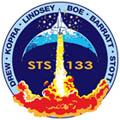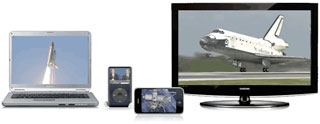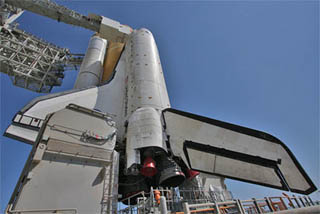 Orbiter: Discovery Mission: STS-133 Payload: Leonardo Launch: Nov. 1, 2010 Time: 4:40 p.m. EDT Site: Pad 39A, Kennedy Space Center Landing: Nov. 12 @ approx. 10:42 a.m. EST Site: KSC's Shuttle Landing Facility  
|
Mission Status Center
Welcome to Spaceflight Now's live coverage of space shuttle Discovery's STS-133 mission to the International Space Station. Text updates will appear automatically; there is no need to reload the page. WEDNESDAY, SEPTEMBER 22, 2010
The incredible machine that is the space shuttle has been the central feature in America's space program for the past three decades. But as forced retirement looms, the orbiters are flying their final missions before becoming museum pieces. Spaceflight Now had the rare treat to visit shuttle Discovery at launch pad 39A and create this photographic collection of the venerable spaceplane.
See our photo special. 0050 GMT (8:50 p.m. EDT Tues.)
The rotating service structure has been moved into position to protect Discovery from the elements and provide access to the vehicle during its stay at the launch pad. The gantry was left open today so Kennedy Space Center employees could see the shuttle up close on the launch pad one last time.
TUESDAY, SEPTEMBER 21, 2010
The shuttle Discovery, mounted atop a mobile launch platform carried by an Apollo-era crawler transporter, was hauled to the launch pad overnight Monday for work to ready the ship for blastoff Nov. 1 on its final flight.
Read our full story. Check out Spaceflight Now's two photo galleries of Discovery's rollout: 0600 GMT (2:00 a.m. EDT)
Space shuttle Discovery trekked to Kennedy Space Center's launch pad Monday night, making the voyage for its 44th and final time.
Bolted to a giant external fuel tank and twin solid rocket boosters atop a mobile launching platform, Discovery embarked on the three-and-a-half-mile trip as the sun set at 7:23 p.m. EDT. That familiar hum of the crawler's engines can be heard all around the VAB area, as hundreds of cheering space center employees and their family members gathered in a special viewing spot. An Apollo-era transporter carried the shuttle stack along Kennedy Space Center's rock-covered crawlerway leading to the oceanfront launch complex at barely a walking pace. Powerful hydraulics jacked up the platform, keeping it level as the crawler ascended the pad's concrete incline. A laser alignment system helped technicians precisely position the platform, then the crawler lowered it onto the pad's pedestals to complete Discovery's rollout at 1:49 a.m. EDT. In the next few hours and days, the methodical process of hooking up the crew module assess and hydrogen vent arms extending from the launch tower, as well as electrical, propellant, communications and other lines between the ground systems and mobile launch platform will begin. The gantry-like rotating service structure will be left open throughout Tuesday to give workers another opportunity to take their own pictures of Discovery. The mission's payload -- the Italian-made Permanent Multipurpose Module and an external pallet holding a spare thermal radiator -- is being readied for flight at Kennedy Space Center's Space Station Processing Facility. The cargo is slated for delivery to the launch pad on October 7 for placement into the gantry's cleanroom and subsequent installation into Discovery's payload bay. Liftoff is scheduled for 4:40 p.m. EDT on November 1. 0550 GMT (1:50 a.m. EDT)
The mobile launch platform was "harddown" on the pad pedestals at 1:49 a.m. EDT, marking the official time for Discovery's arrival at pad 39A.
0545 GMT (1:45 a.m. EDT)
The platform is slowly lowering down to the pedestals.
0525 GMT (1:25 a.m. EDT)
The crawler has finished tonight's drive from the Vehicle Assembly Building, delivering space shuttle Discovery atop launch pad 39A. But the rollout's official conclusion time will be marked when the launch platform is lowered down and secured to the pad pedestals.
0515 GMT (1:15 a.m. EDT)
The crawler is getting the mobile launch platform positioned over the pad pedestals where Discovery will be perched for its November 1 blastoff.
0455 GMT (12:55 a.m. EDT)
Discovery has climbed up the concrete ramp of launch pad 39A, its crawler-transporter having used massive hydraulic pistons to keep the mobile platform level.
Now atop the pad surface, a precision laser guidance system will help align the platform over the pad pedestals. The crawler will lower the platform onto the pedestals to complete the rollout. 0430 GMT (12:30 a.m. EDT)
The crawler transporter hauling space shuttle Discovery is now climbing the concrete ramp to the launch pad.
0410 GMT (12:10 a.m. EDT)
Discovery has reached the pad perimeter gate.
0345 GMT (11:45 p.m. EDT Mon.)
The crawler is making the curve to reach the entrance to launch pad 39A.
0315 GMT (11:15 p.m. EDT Mon.)
Meanwhile, an Atlas 5 rocket is getting ready to launch from California carrying a U.S. national security satellite. Follow our live coverage.
0250 GMT (10:50 p.m. EDT Mon.)
Discovery is passing by the Kennedy Space Center's Visitor Center observation gantry as the rollout proceeds smoothly. That's where the crawlerway forks into two pathways -- go left to pad 39B or straight ahead to pad 39A.
0225 GMT (10:25 p.m. EDT Mon.)
Hauling the shuttle stack out to launch pad 39A on this 3.5-mile trek is one of NASA's two Apollo-era crawler-transporters. The combined weight of the transporter, mobile launch platform and shuttle Discovery is 17.5 million pounds.
The stone-covered pathway connecting the VAB to the launch pad is 130 feet wide -- almost as broad as an eight-lane highway. Two 40-foot-wide lanes are separated by a 50-foot-wide median strip. The average depth is seven feet. About 30 people are aboard the transporter to operate it during the rollout, including three drivers -- a prime and backup in the front cabin and one in the rear -- a jacking and leveling operator, a control room operator to run crawler systems and talk with the Launch Control Center, two electricians, two electronic technicians and four diesel mechanics for starting, monitoring and shutting down the transporter's engines. The other team members are mechanics watching over the roll and helping with the platform's docking to the launch pad. The transporter consumes 126 gallons of diesel fuel in each mile it travels from the VAB to pad. The vehicle has a fuel capacity of 5,000 gallons. 0125 GMT (9:25 p.m. EDT Mon.)
The transporter is making good progress now two hours into the rollout.
0100 GMT (9:00 p.m. EDT Mon.)
Our live video stream from the Kennedy Space Center press site continues as Discovery inches its way to the launch pad in the nighttime darkness.
0025 GMT (8:25 p.m. EDT Mon.)
A giant crowd of cheering space center employees and their family members are gathered along the crawlerway as space shuttle Discovery heads eastward.
Officials handed out more than 800 car passes for workers to escort viewers to Discovery's final rollout. 2345 GMT (7:45 p.m. EDT)
As the sun sets, space shuttle Discovery has emerged from the 52-story landmark Vehicle Assembly Building where it spent the past two weeks being attached to the external fuel tank and twin solid rockets atop a mobile platform.
2324 GMT (7:24 p.m. EDT)
ROLLOUT BEGINS. The crawler-transporter has started driving space shuttle Discovery from the cavernous Vehicle Assembly Building to Kennedy Space Center's launch pad 39A for the ship's final flight before retirement.
2320 GMT (7:20 p.m. EDT)
As launch platform raises off the pedestals, observers on the rollout team will report all is in readiness. The top speed for the transporter will be 0.8 mph for today's move.
2301 GMT (7:01 p.m. EDT)
Approval has been given for the crawler-transporter to start hydraulically jacking up the mobile launch platform from the Vehicle Assembly Building pedestals. Rollout should begin shortly.
2230 GMT (6:30 p.m. EDT)
Power is being transferred over to the mobile equipment from ground sources in the VAB for rollout.
2130 GMT (5:30 p.m. EDT)
The rollout team is getting the crawler-transporter moved into the Vehicle Assembly Building and positioned beneath shuttle Discovery's mobile launch platform. NASA is hoping to get Discovery's moving by 7:30 p.m. EDT, a little earlier than originally planned.
1930 GMT (3:30 p.m. EDT)
Weather forecasters are predicting favorable conditions for Discovery's rollout from the Vehicle Assembly Building tonight. The outlook includes some scattered clouds, good visibility, northeasterly winds of 12 to 17 knots and a temperature in the low 80s F.
There is no chance of any lightning in the area or violating the wind limits. MONDAY, SEPTEMBER 20, 2010
NASA is ready to roll the fully assembled space shuttle Discovery to Kennedy Space Center's launch pad 39A tonight beginning at 8 p.m. EDT.
The ground team responsible for moving the spacecraft along the 3.5-mile stone-covered roadway from the Vehicle Assembly Building to the seaside pad is scheduled to report for duty at 4 p.m. The crawler-transporter will hydraulically lift the mobile launching platform and carry the shuttle on the six-hour trip. If all goes according to plan, Discovery should be secured atop the pad and the pad swing arms extended long before dawn. Watch this page for live coverage! FRIDAY, SEPTEMBER 17, 2010
Space shuttle Discovery's interface test has wrapped up successfully in preparation for the ship's final launch into orbit.
Range safety system and pyrotechnic initiator controller testing, plus booster hydraulic leak checks have been completed. And the bolt on the T-0 umbilical was removed after efforts to drill it out. Meanwhile, the various work platforms that cocoon the shuttle inside the Vehicle Assembly Building are being retracted in sequential fashion. The crawler-transporter used to haul Discovery to the launch pad is parked just outside the VAB. No work is scheduled over the weekend. Rollout preps will resume on Monday, leading to first motion at 8 p.m. EDT. We'll have complete live coverage of rollout and streaming video right here on this page. If you will be away from your computer but would like to receive Discovery updates, sign up for our Twitter feed to get text messages on your cellphone. U.S. readers can also sign up from their phone by texting "follow spaceflightnow" to 40404. (Standard text messaging charges apply.) THURSDAY, SEPTEMBER 16, 2010
Preparations for rollout are formally underway at the Vehicle Assembly Building. Booster hydraulic testing and nozzle steering system checks are complete.
The Shuttle Interface Test has resumed after technicians fixed a bent pin within a connector on the solid rocket booster electronics assemblies. The problem, which had interrupted Discovery's testing, was uncovered during checks of the left booster's range safety system equipment. Another issue also being resolved is a bolt that got bumped and became lodged during mating of the tail service masts to the aft fuselage of Discovery. Workers are drilling out the bolt and hope to finish mating the umbilicals today. TUESDAY, SEPTEMBER 14, 2010
Inside the Vehicle Assembly Building today, workers were beginning the two-day Shuttle Interface Test to ensure orbiter Discovery, the external fuel tank, twin solid rocket boosters and mobile launching platform are electrically wired together properly.
The shuttle stack was mechanically mated together on Saturday, then internal work with the umbilicals and the orbiter's tail servicing connections were made. Other activities have included installation of various ordnance systems and the camera package embedded in Discovery's belly to view the fuel tank jettison during launch. Rollout to launch pad 39A remains targeted to begin at 8 p.m. EDT next Monday. The three-and-a-half mile journey should end with the shuttle's arrival at the complex about six hours later. Read our earlier status center coverage. |
Upcoming mission events:
Space video for your computer, iPod or big screen TV
Experience the space program like never before become a subscriber today |
